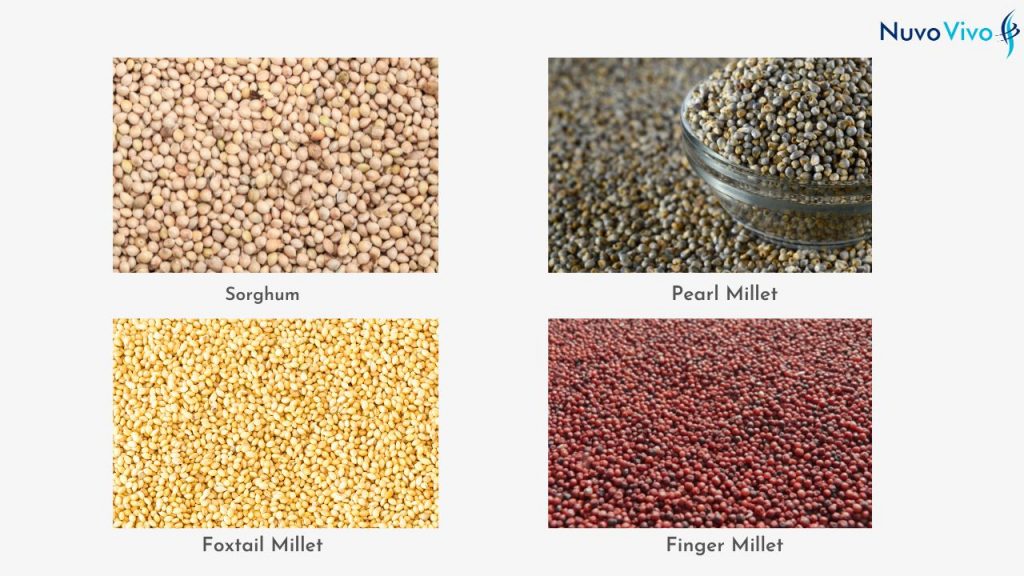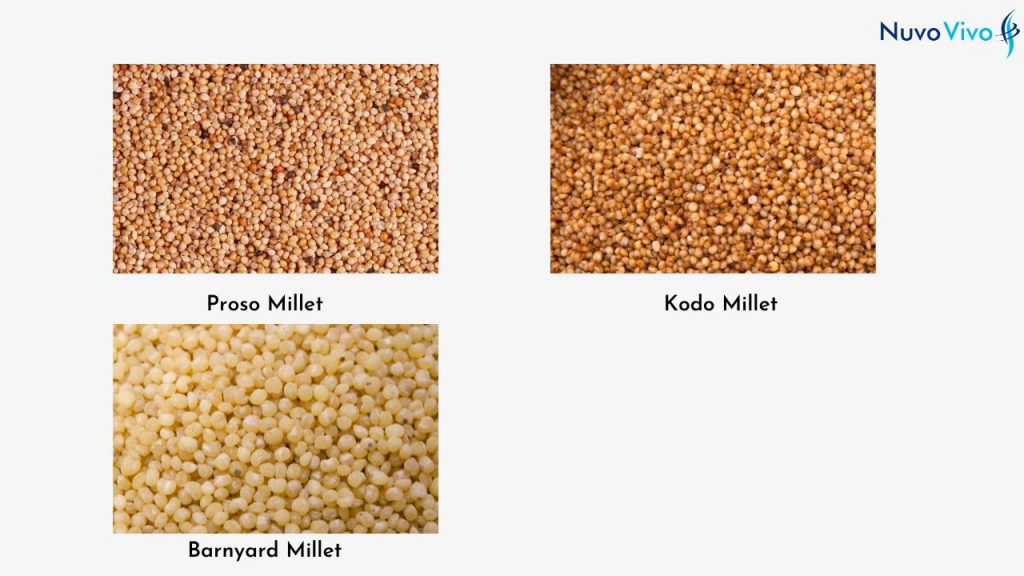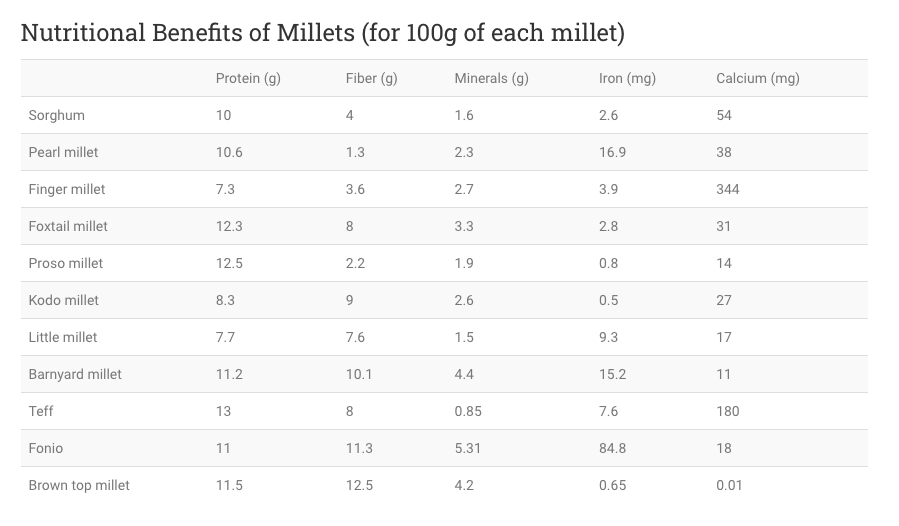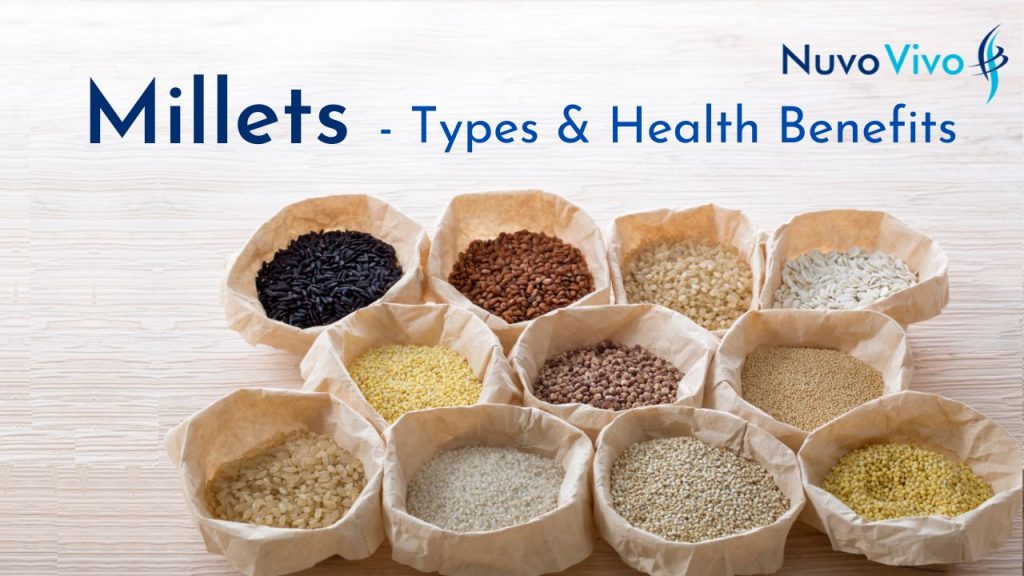Millets are a group of small-seeded cereal crops that are grown for food and animal feed. They are considered to be ancient grains and are believed to have originated in Africa and Asia over 5,000 years ago. In ancient times, millets were an important food source for many civilizations, including the Chinese, Egyptians, and Indians. They were valued for their ability to grow in dry and arid conditions and were a reliable source of food even during droughts.
Over time, millets fell out of favour as rice and wheat became more prevalent, but they remained a staple food in many rural areas, particularly in Africa and Asia. Today, millets are gaining popularity globally as a nutritious and environmentally friendly alternative to wheat and rice. They are being promoted by health organizations, food companies, and governments as a way to improve diets and promote sustainable agriculture.
There are several different types of millets, including sorghum, pearl millet, foxtail millet, finger millet, proso millet, kodo millet, and barnyard millet. Millets are known for their high nutritional value, including fiber, vitamins, and minerals, and they are also gluten-free and have a low glycemic index.
Nutritional Benefits of Millets
Millets are a highly nutritious food that provides a range of health benefits. Some of the key nutritional benefits of millets include:
- High in Fiber: Millets are a rich source of dietary fiber, which helps to promote healthy digestion and prevent constipation.
- Rich in Minerals: Millets are a good source of minerals such as iron, magnesium, and phosphorus, which are important for maintaining strong bones and a healthy immune system.
- Low in Fat: Millets are low in fat, which makes them an ideal food option for people who are trying to reduce their overall calories and fat intake
- Gluten-Free: As mentioned before, millets are naturally gluten-free, making them a safe food option for people with celiac disease or gluten intolerance.
- Rich in Antioxidants: Millets are a good source of antioxidants, which help to protect the body against damage from harmful molecules called free radicals.
- Good Source of Protein: Millets are a good source of protein, particularly when compared to other grains. This makes them a valuable food option for vegetarians and vegans who may need to supplement their diets with alternative sources of protein.
- Low Glycemic Index: Millets have a low glycemic index, which means that they are slowly digested and absorbed into the bloodstream. This can help to regulate blood sugar levels and reduce the risk of developing type 2 diabetes.
Different types of Millet
All millets are rich in fiber and have a fairly higher amount of protein. Most of the millets are rich in minerals like calcium, phosphorous, and iron. They are also rich in B-vitamins viz. vitamins like thiamine (Vit B1), riboflavin (Vit B2), folic acid (Vit B9), pantothenic acid (Vit B5), and niacin (Vit B3). They are well-suited to grow in dry and arid conditions, making it a reliable source of food even during droughts. There are several different types of millets, each with its own unique characteristics and uses. Some of the most common types of millets are-
Sorghum (Jowar)
Sorghum, known as Jowar in India, is a cereal crop that is widely cultivated in many parts of the world, particularly in Africa and Asia. It is a versatile grain that can be used for food, animal feed, and fuel.
Sorghum is different from other millets in a number of ways. For one, it is larger and more versatile, and can be used for a wider range of applications, including food, animal feed, and fuel. In India, sorghum (Jowar) is widely cultivated in many parts of the country and is a staple food for many rural communities. It is rich in potassium and phosphorus, and also has a good amount of calcium and small amounts of iron.
Pearl Millet (Bajra)
Pearl millet, known as Bajra in India, is a type of millet that is widely cultivated in many parts of the world, particularly in Africa and India. It is the most widely grown type of millet and is a staple food in many rural communities. It is abundant in minerals such as magnesium and calcium.
Foxtail Millet (Kangni)
Foxtail millet, known as Kangni in India, is a type of millet that is widely cultivated in many parts of the world, particularly in Asia. It is known for its small, seed-like grains and is a staple food in many rural communities.
Finger millet (Ragi)
Finger millet, also known as ragi, is a staple food in many rural communities and is known for its high nutritional value. It is rich in calcium, iron and phosphorus. In terms of its cultivation, finger millet is well-suited to growing in high-altitude areas, and is a reliable source of food even during droughts. It is also a hardy crop that can withstand harsh growing conditions, making it a popular option for farmers in many developing countries.
Proso Millet (Barri)
Proso millet, also known as Barri, is a type of millet that is widely cultivated in many parts of the world, particularly in Asia and North America. It is known for its small, seed-like grains and is a staple food in many rural communities. It is rich in iron, copper, zinc and manganese
Kodo Millet (Varagu)
Kodo millet, also known as “varagu” in India, is a type of millet that is widely cultivated in many parts of the world, particularly in Asia. It is known for its small, seed-like grains and is a staple food in many rural communities. Kodo millet has comparatively higher amount of fiber as compared to other millets. However, this can vary depending on the extend to which they are processed.
Barnyard millet (Jhangora)
Barnyard millet, also known as “Jhangora” in India, is a type of millet that is widely cultivated in many parts of the world, particularly in Asia. They are rich in calcium, phosphorus and iron


Other Millets
There are several other types of millet, including:
- Little Millet: Also known as “kutki” in India, little millet is a small-seeded variety of millet that is grown primarily in India and other parts of Southeast Asia.
- Browntop Millet: This type of millet is grown primarily in Asia, including India and China, and is known for its high fiber content and digestibility.
- Black Millet: This type of millet is grown primarily in Asia and Africa, and is known for its high nutrient content and gluten-free properties.
- Teff: This type of millet is native to Ethiopia and is a staple food in the country. It is used to make traditional Ethiopian dishes such as injera.
- Job’s Tears: Also known as “yi yi ren” in China, Job’s Tears is a type of millet that is grown primarily in Asia.

Antioxidant benefits of millets
Millets are a rich source of antioxidants, which are compounds that protect the body against damage from harmful molecules called free radicals. Some of the antioxidants found in millet are
- Phenolic compounds: Millets are a rich source of phenolic compounds, such as ferulic acid, p-coumaric acid, and vanillic acid, which have potent antioxidant properties.
- Tocopherols: Millets are also a good source of tocopherols, which are forms of vitamin E, a powerful antioxidant.
- Carotenoids: Millets contain carotenoids, such as beta-carotene, lutein, and zeaxanthin, which are pigments that act as antioxidants in the body.
- Selenium: Millets are a good source of selenium, a mineral that acts as an antioxidant and helps to protect against oxidative stress and inflammation. Selenium also plays an important role in thyroid hormone production
The antioxidant content of millets can vary depending on factors such as the variety of millet, growing conditions, and processing methods.
Also Read:
Are all millets gluten-free?
Yes, all millets are naturally gluten-free. This makes them a good option for people who are sensitive to gluten or have celiac disease, which is an autoimmune disorder that causes a reaction to gluten.
Because millets are gluten-free, they can be a valuable part of a healthy diet for people who are looking to avoid gluten. In addition to being gluten-free, millets are also rich in fiber, vitamins, and minerals, and have a low glycemic index, making them a nutritious food option for people with diabetes or other health conditions.
Also Read: Gluten – Are you are risk?
Millets – Culinary Uses
Millets have been used as a staple food in many cultures for thousands of years, and have a variety of culinary uses. Some of the common ways to use millet in cooking include:
- Porridge: Millets can be made into a nutritious and filling porridge by boiling them in water or milk and sweetening with honey or sugar.
- Rice Substitute: Millets can be used as a substitute for rice in many dishes, such as stir-fries, pilafs, and curries. They can also be used to make savory or sweet puddings.
- Flatbreads: Millets can be ground into flour and used to make a variety of flatbreads, such as roti, chapati, or naan.
- Snacks: Millets can be popped like popcorn and seasoned with salt, spices, or sweeteners to make a crunchy snack.
- Baked Goods: Millet flour can be used in baking to make cakes, breads, and other baked goods.
- Add-In for Soups and Salads: Millets can be cooked and added to soups, stews, and salads for extra texture and nutrition.
- Breakfast Cereal: Millets can be served as a hot cereal for breakfast, similar to oatmeal.
These are just a few examples of the many ways to use millet in cooking. Millets are versatile and can be used in a variety of dishes to add extra nutrition and flavor.
Disadvantages of Millets
From a nutritional perspective, there are a few potential downsides to millets:
- Low Lysine: Millets have a lower lysine content compared to other staple crops such as rice and wheat. Lysine is an essential amino acid that is important for human growth and development.
- Low Thiamine: Some types of millets, such as proso millet, have low thiamine content. Thiamine is an important B-vitamin that is essential for the metabolism of carbohydrates.
- Limited Variability: Millets are a relatively narrow group of crops, meaning that there is limited variability in terms of their nutritional composition.
However, these potential downsides can be mitigated by consuming a diverse diet that includes other sources of essential nutrients. Additionally, many types of millets are rich in other important nutrients, such as fiber, iron, and magnesium, making them a valuable addition to the diet. Overall, millets are a nutritious food that can offer many health benefits when consumed as part of a balanced diet
Also Read: How to reverse diabetes?
Millets – FAQ
Can millets cause any stomach issues?
Millets themselves do not necessarily cause stomach issues like bloating or indigestion. However, some people may be sensitive to certain types of millets and may experience digestive symptoms as a result.
This can occur due to a variety of factors, including individual intolerance to certain components in millet, such as FODMAPs in those with irritable bowel syndrome. Additionally, some people may experience digestive discomfort after consuming large quantities of millet, especially if they are not used to eating high-fiber foods.
Are millets difficult to digest? Which millet is easiest to digest?
Millets are not necessarily difficult to digest for most people, but it can depend on the individual and the specific type of millet. Millets are generally considered to be easy to digest, as they are high in fiber and contain complex carbohydrates that are slowly absorbed by the body.
As mentioned earlier, some people, however, may experience digestive discomfort after consuming large quantities of millet, if they are not used to eating high-fiber foods.
Which millet is best for IBS?
For individuals with irritable bowel syndrome (IBS), it is best to choose millets that are low in fermentable oligo-, di-, mono-saccharides and polyols (FODMAPs). FODMAPs are types of carbohydrates that can be difficult for some people to digest, leading to symptoms such as bloating, gas, and abdominal pain.
Pearl millet, kodo millet, and finger millet are considered to be low in FODMAPs, making them good options for people with IBS. However, it is important to note that everyone’s tolerance to FODMAPs is different, and it is best to determine what works best for you. In general, it is recommended for individuals with IBS to follow a low-FODMAP diet and to limit their consumption of high-FODMAP foods. Consuming millet in moderation and alongside a balanced diet with a variety of other healthy foods can help to ensure good gut health.
Should millets be soaked before cooking?
Soaking millets before cooking is not required, but it can be beneficial in some cases. Soaking millets before cooking can help to reduce the cooking time, making it quicker and more convenient to prepare. Soaking can also improve the texture of millet, making them softer and easier to eat.
Soaking millet can help to increase the absorption of certain nutrients, such as B vitamins and minerals. It can also help to break down some of the phytic acid, making the grains easier to digest and improving their overall nutritional value. If you choose to soak millet, it is important to drain and rinse them thoroughly before cooking. The soaking time can vary from one millet to another, but generally, millets can be soaked for about 6-8 hours or overnight
Can a diabetic patient eat millet?
Millets are excellent for blood glucose management for diabetic patients. Because of the high fiber content, the blood glucose does not spike making millet suitable for glycemic management
Which is the healthiest millet?
As discussed above, all millets are rich in fiber and protein and also have a variety of nutrients and minerals such as B-Vitamins, calcium, iron, phosphorous, magnesium, potassium, zinc etc. It is hard to pick on millet over another and name them the best! We suggest including all types of millets alongside a balanced diet
Which millet is best for diabetes?
All millets are rich in fiber and protein and can be included in the diet for a diabetic person
Also Read: Is honey good for diabetes?
Who should avoid millets?
Millets should be avoided if they cause any allergy, skin rashes or indigestion and irritable bowel. Otherwise, millets are safe to be included in the diet
Can we eat millets daily?
Millets can be included daily. However, it is always a best practice to include a variety of millets and whole grains along with a variety of vegetables and protein sources. Consuming the same kind of food more frequently and avoiding other options can cause nutrient deficiency. A balanced diet is what balances all types of nutrients and nourishes the body well
Does millets reduce belly fat?
No! Millets are not responsible for losing belly fat or losing weight. To lose weight, one needs to be on a calorie deficit. ie – eat fewer calories than the calories burnt in a day. If you overeat any food, including millet, and end up in a calorie surplus, you will gain weight instead of losing weight. However, millet being rich in fiber and protein can be satiating and hence your chances of overeating will be lesser!
About NuvoVivo
NuvoVivo is an online health and fitness company that helps its clients manage lifestyle diseases. Our clients join us from across the world to manage or reverse conditions such as diabetes (and its complications), cardiovascular diseases (hypertension, high cholesterol), fatty liver, PCOS, thyroid disorders, IBS etc. We help them reduce their reliance on medications through structured and scientific lifestyle changes that suit their cultural habits and medical conditions. Our team provides a diet plan, exercise plans and the necessary follow-up and support in helping them achieve this
Reach for Consultations @ https://bit.ly/NVConsultation
More about NuvoVivo @ https://linktr.ee/nuvovivo


This Post Has One Comment
I like the helpful information you provide in your articles